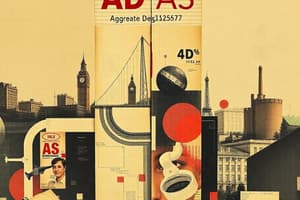Podcast
Questions and Answers
In the AD-AS model, which two variables are depicted in the older and static version?
In the AD-AS model, which two variables are depicted in the older and static version?
- Interest rate and inflation
- Aggregate demand and supply
- Inflation and output
- Output and price level (correct)
When did the AD-AS model become one of the primary simplified representations of macroeconomic issues?
When did the AD-AS model become one of the primary simplified representations of macroeconomic issues?
- Around 2000
- Around 1970 (correct)
- Around 1950
- Around 1985
What is the primary policy instrument in the modified version of a dynamic AD-AS model developed around 2000?
What is the primary policy instrument in the modified version of a dynamic AD-AS model developed around 2000?
- Inflation
- Aggregate supply
- Output
- Interest rate (correct)
Which economic issue made the AD-AS model an important political issue toward the end of the 1970s?
Which economic issue made the AD-AS model an important political issue toward the end of the 1970s?
What does the dynamic version of the AD-AS model show in addition to output?
What does the dynamic version of the AD-AS model show in addition to output?
In the AD-AS model, what does AS stand for?
In the AD-AS model, what does AS stand for?
What is the main difference between the dynamic AD–AS model and the dynamic stochastic general equilibrium (DSGE) models?
What is the main difference between the dynamic AD–AS model and the dynamic stochastic general equilibrium (DSGE) models?
What was the contribution of O.H. Brownlee to the AD–AS diagram?
What was the contribution of O.H. Brownlee to the AD–AS diagram?
What prompted the need for a model that incorporated aggregate supply and could explain changes in the price level?
What prompted the need for a model that incorporated aggregate supply and could explain changes in the price level?
Which textbooks presented an AD–AS model in the late 1970s and later became widely used?
Which textbooks presented an AD–AS model in the late 1970s and later became widely used?
What led to the rise of the dynamic AD–AS version and the traditional version of the IS–LM diagram?
What led to the rise of the dynamic AD–AS version and the traditional version of the IS–LM diagram?
Who published an article in Journal of Political Economy in 1950, which is allegedly the first published version of a full AD–AS model in Y-P space?
Who published an article in Journal of Political Economy in 1950, which is allegedly the first published version of a full AD–AS model in Y-P space?
According to A.K. Dutt, where did the AD–AS diagram first make its appearance in 1948?
According to A.K. Dutt, where did the AD–AS diagram first make its appearance in 1948?
What was different about Kenneth E. Boulding's version of the diagram in output-price space compared to Brownlee's version?
What was different about Kenneth E. Boulding's version of the diagram in output-price space compared to Brownlee's version?
Flashcards are hidden until you start studying




